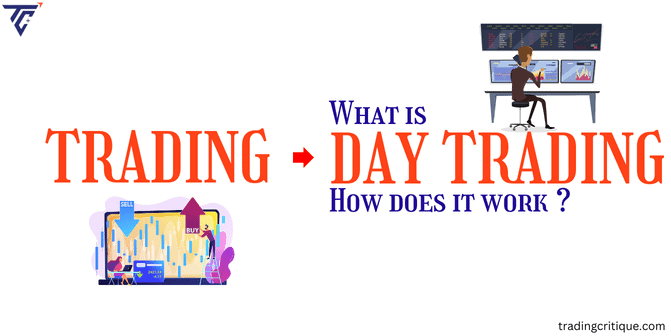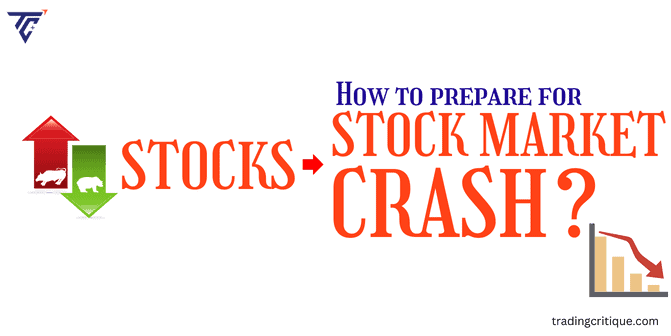Ultimate Guide: What Is Day Trading and How Does It Work?
Day trading is a quick way of buying and selling assets like stocks within the same day. The goal is to earn money by taking advantage of quick changes in prices. Unlike long-term investing, day traders exit all trades by the end of the day.

It is risky and needs practice and a tolerance for uncertainty. To avoid potential losses, we provide you with beginner-friendly guidance and strategies to help you become an expert day trader. Let’s take a closer look.
What is day trading?
Day trading is where people buy and sell stocks within a single day to make a profit. Instead of holding onto investments for a long time, day traders make trades within the same day. They aim to profit from short-term price changes and avoid risks that can happen overnight.
Day traders often use tools like borrowed money (called leverage) to increase their buying power. In the U.S., there are rules about how much they can borrow, and if they make a lot of trades, they need to have at least $25,000 in their account.
What is day trading stocks? People who do day trading can trade things like stocks, options, or currencies. Some follow a strategy where they hold onto things for just a few minutes or even seconds.
Day trading became more popular because of changes in the rules in the 1970s and the rise of electronic trading platforms. Recently, more regular people have gotten into day trading, especially during times of big changes in the stock market.
It’s a risky activity that requires quick decisions and an understanding of how the market works.
Quick insights
- Day trading offers a way to profit from short-term market changes, providing an exciting alternative to traditional, long-term investing.
- Achieving success in day trading need extensive knowledge, disciplined planning, and a profound understanding of the market.
- Before starting, learn the basics, practice with a demo account, and be aware of the risks associated with short-term trading.
History of day trading
Before 1975, stock trading in the U.S. incurred expensive fixed fees of 1%. However, in 1975, the rules changed, and fees dropped. In the past, it took a long time to complete stock transactions.
By the ’90s, technology had reduced the transaction time to just two days for safety. Electronic networks, like NASDAQ, made trading easier since 1971. During this period, market makers emerged, buying low and selling high, making a profit from the difference.
After a stock market crash in 1987, new rules required market makers to be transparent about their prices. Another change, called Small-order execution system (SOES), forced market makers to quickly execute small orders.
In the late ’90s, more people could trade electronically. The dot-com bubble saw big profits, but it eventually burst in 2000, resulting in significant losses.
Around the same time, firms started let people trade foreign exchange (forex) and derivatives electronically. This became popular, especially in the UK, allowing traders to take risks with small amounts of money but with higher risks.
How does day trading work?
What is day trading and how does it work? A day trade is like any regular stock trade, but with a twist – both buying and selling the stock happens on the same day, sometimes within seconds.
Imagine the company called Intuitive Sciences Inc. (ISI) and notices a pattern: when the Nasdaq stock market goes up by more than 0.4%, ISI tends to go up by at least 0.6%. The trader thinks today will be one of those days.
So, the trader buys 1,000 shares of ISI when the market opens, waits for ISI to reach a specific price, maybe up by 0.6%, and then quickly sells all the shares. This whole process is a day trade. It’s not about whether ISI is a good investment; it’s about taking advantage of a trend.
But what if ISI goes against the trend and loses 0.8%? The trader will still sell, even if it means taking a loss. Day trading is about reacting quickly to market movements.
How to start day trading for beginners?
How to begin day trading. To begin day trading, follow these steps:
Gain knowledge and experience in the marketplace
- Understand market fundamentals and technical analysis.
- Deepen your knowledge of specific products you plan to trade.
Develop a trading plan
- Decide how much of your money you're willing to risk tolerance, profit targets, and stop-loss levels on a single trade.
- Consider factors like stock volatility, liquidity, news, and sentiment.
Choose a brokerage platform
- Look for features like commission-free trades, market data, and research tools suitable for day trading.
Set up your brokerage account
- How to start a day trading account? Once you choose it then create an account to buy and sell securities.
- You can gain access to research tools such as charts, market news, scanners, and stock screeners.
Start with a demo account
- Practice trading with virtual money to get comfortable with the platform and your strategy before using real capital.
Required capital and account restrictions
- Use only risk capital that you can afford to lose, especially for day trading which involves a high degree of risk.
- Be aware of minimum balance requirements for day trading accounts (at least $25,000).
Automate trading processes
- Use different order types to automate your trades.
- Set limits for buying and selling stocks based on price movements.
Develop your skills and knowledge
- Consider taking day trading courses or joining online forums to learn from others.
- Stay updated with market news and trends.
Develop discipline
- Stick to your trading criteria follow your plan and manage your emotions.
- Plan your trading sessions during market hours and prioritize accordingly.
Adopt the right mindset
- Assess your ability to handle short-term losses.
- Confirm your commitment to the high-risk nature of day trading.
Day trading strategies
Does day trading work? Day trading is about quickly buying and selling financial things, like stocks, in a single day. To do it right, you need a good plan and shouldn’t make quick decisions. Traders use various strategies to make money, adapting to the changing market.
Here are some common day trading strategies are:
Range trading
Range traders look for assets that usually stay within a certain price range. They aim to buy when the price is low in the range and sell when it’s high. Timing is important and unexpected news or events can mess up the price ranges, causing losses.
Scalping
Scalping is a faster version of range trading. Day traders buy and sell small price changes many times a day, trying to make a small profit each time. They use short-term price charts to spot trends quickly.
Trading the news
Day traders closely watch the news to make money when big things happen in the market, like when new job reports come out or when the Federal Reserve changes interest rates. They try to guess which way prices will go in response to the news or find assets that haven’t fully adjusted to the new information.
Momentum trading
Investments often follow trends. If a stock goes down, it might keep going down, and the opposite is true for rising stocks. Momentum traders try to take advantage of these trends, using past price movements to predict future ones. They use technical indicators and charts to decide when to buy or sell.
Fading
Fading is when a day trader goes against the crowd. They buy assets that others are selling heavily or sell assets that have gone up in value. The idea is that market prices sometimes move too far in one direction due to everyone following the herd.
The goal is to profit when prices come back to average. But it’s risky because it goes against the current trend and can result in losses.
Leverage
Day traders often use borrowed money, or leverage, for their trades. This allows for higher potential gains if things go well, but it also means losing money more quickly. Brokers charge interest on these borrowed funds.
Rebate trading
Rebate trading is about making money through Electronic Communication Networks (ECNs) by earning commissions for adding liquidity to the market. Traders focus on lower-priced, high-volume stocks to maximize returns.
Price action trading
Price action trading means making decisions about buying or selling stocks without using typical indicators. Traders using this method look at how prices move and other basic market information to decide when to trade.
It’s considered a simple approach, but it’s not necessarily easier. To do it well, you need to understand how markets work. The good thing is, it works in many different markets like stocks, foreign exchange, and more.
How effective is day trading?
Day trading is when people buy and sell stocks quickly in one day to make money. Some like it because you can make profits fast, especially with online platforms making it easy for everyone.
It’s exciting because you get to decide quickly, and you don’t have to worry about things happening overnight. But, it’s not easy – most people end up losing money.
You might also have to pay fees, and it takes time to learn how to do it well. So, while it can be cool, it’s important to be careful and learn a lot before trying it.
How to manage risk in day trading?
To keep your money safe while day trading, follow these simple steps to manage your risk:
- Decide how much you're willing to lose on a trade ahead of time.
- Only use a small portion of your money for each trade (1-2%).
- Don't put all your money into one investment; spread it out.
- Be careful with borrowing money (leverage).
- Look for trades where you could make at least twice as much as you might lose.
- Stick to your plan and don't let emotions drive your decisions.
- Keep learning and adjusting your strategy based on what works and what doesn't.
Is day trading legal?
Yes, day trading is legal, but it’s complicated and better suited for experienced professionals. Most people may find it challenging due to the time, money, and knowledge needed for success.
Pro Tip
To complement your trading activities, whether in day trading or other investment styles, consider enhancing your success with our trusted Forex brokers. Staying well-informed about various investment options such as CFDs, forex,stocks, and cryptocurrencies is crucial in today’s dynamic financial landscape. By utilizing authentic broker reviews, you gain valuable insights that aid in making intelligent trading decisions, thereby refining your approach and potentially increasing your chances of success in the challenging world of trading.
Conclusion
Day trading involves buying and selling financial instruments (like stocks) within the same trading day. It can be risky because even though some traders make a lot of money, most end up losing.
If you want to try day trading, you need to be well-informed, have enough money, and be ready for the possibility of losing. It’s not a guaranteed way to make money, and success requires a good understanding of the market, enough funds, and the right tools.
While it may seem exciting, it’s important to approach day trading with caution and be aware of the potential risks involved.
Frequently Asked Questions
1. What's the key rule for day trading?
The first rule of day trading is to always sell your position before the market closes. Day traders avoid holding onto losing positions overnight due to higher margin requirements and the risk of bigger losses from overnight news.
2. Is day trading easy?
Day trading isn’t a quick and easy way to make money. Success requires time, effort, and managing risks. Don’t anticipate making a fortune overnight.
3. What is buying power in day trading?
Day trading’s buying power is the total funds an investor has for trading, including cash in the account and available margin. According to FINRA rules, pattern day traders can trade up to four times their maintenance margin excess from the previous day’s close.
4. Does anyone make money day trading?
Day trading can sometimes make money if you’re good at predicting stocks or lucky with certain types. Pros might succeed, but they may not risk their money. Regular people using their funds usually don’t make much, and often, it can cause more harm than good.
5. Is day trading suitable for beginners?
The Securities and Exchange Commission (SEC) warns that most beginners in day trading often face significant financial losses initially, and many don’t end up making profits.
Latest Posts
How to Pick Best Stocks for the Long Term investment
Long-term investment is a good option for those looking to invest their...
Read MoreWhat Is Stock Trading and How Does It Work
Stock trading involves buying and selling company shares to make a profit,...
Read MoreHow to Choose the Right Mutual Funds
What is a mutual fund? A mutual fund is an investment pool...
Read MoreHow to Prepare for a Stock Market Crash?
Investing for the long term can give you more profit by investing...
Read MoreWhat is Crypto Staking
What does staking crypto mean? Staking is like putting your crypto assets...
Read MoreEverything You Need to Know: How to Invest Your Money
Money is crucially important in life. Its value depends on how it...
Read MoreWhen, Where and How to Buy Bitcoins Online 2024?
Bitcoin is digital money that allows people to send money to each...
Read MoreWhat are Penny Stocks and How Do They Work?
A penny stock is called a small investment business. It has the...
Read MoreWhat are the Top Benefits of AvaTrade
AvaTrade is a market maker and regulated broker offering online trading services...
Read More










